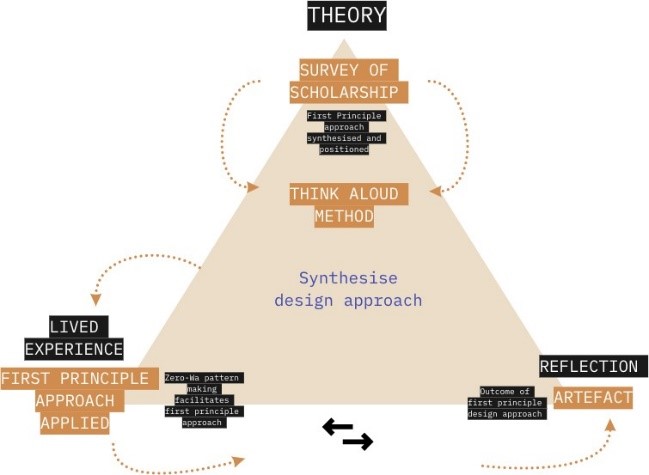Exploring Low-Waste Patternmaking Techniques for Sustainable Solutions in Fashion Industry
Abstract
 Abstract Views: 0
Abstract Views: 0
In the realm of sustainable fashion, designers are actively exploring innovative strategies to reshape their design processes. This study aims to unveil foundational sustainability principles integrated into sustainable fashion praxis using design thinking methodologies. The focus is on practical low-waste patternmaking as a testing ground to assess these principles' feasibility. The research methodology employs a qualitative framework grounded in pragmatism, allowing for a deep engagement in an exploratory data collection process led by a researcher-practitioner in the field of fashion design. While the primary focus is on the core fashion design process, the goal is to align sustainability strategies with key stages in conventional design and production. By aligning the fundamental fashion design process with responsible consumption and production, the study advocates for the adoption of innovative methods that deviates from traditional practices. The study's findings presented comparative insights between conventional approaches and modern sustainable practices. Further exploration of digital advancements in pattern design can streamline sustainability implementation. In conclusion, this challenging yet rewarding study emphasized practical problem-solving strategies in a fashion that is distinct from technical and creative knowledge applications.
Downloads
References
A. Gwilt and T. Rissanen, Design for Sustainability, Changing the Way We Make and Use Clothes. Earthscan, 2011.
K. Fletcher and L. Grose, Fashion & Sustainability: Design for Change. Laurence King, 2012.
A. Gwilt and T. Rissanen, Producing Sustainable Fashion, Points for Positive Intervention by The Fashion Designer. Routledge, 2011.
P. Sinha, “The role of design through making across market levels in the UK fashion industry,” Des. J., vol. 3, no. 3, pp. 26–44, 2000, doi: https://doi.org/10.2752/146069200789390079
R. Rissanen, “Types of fashion design and patternmaking practice,” in Proc. Nordic Des. Res. Conf., 2007, pp. 1–6.
A. Gwilt, “Integrating sustainable strategies in the fashion design process: A conceptual model of the fashion designer in haute couture,” Ph.D. dissertation, RMIT Univ., Melbourne, Aust., 2012.
H. McQuillan, “Zero-Waste design practice: Strategies and risk taking for garment design,” in Shaping Sustainable Fashion: Changing the Way We Make and Use Clothes, A. Gwilt and T. Rissanen, Eds. Routledge, 2011, pp. 83–97.
R. Rissanen, “The fashion system through a lens of zero-waste fashion design,” in Routledge Handbook of Sustainability, K. Fletcher and M. Tham, Eds. Routledge, 2014, pp. 201–209.
T. Rissanen, “Zero- waste fashion design: A study at the intersection of cloth, fashion design and pattern cutting,” Ph.D. dissertation, Univ. Technol., Sydney, 2013.
H. Joseph-Armstrong, Patternmaking for Fashion Design. Prentice Hall, 2006.
N. Cross, Designerly Ways of Knowing. Springer, 2006.
B. Lawson, What Designers Know. Routledge, 2012.
K. Dorst, Design Beyond Design. Elsevier, 2019.
K. Fletcher, Sustainable Fashion and Textiles, Design Journey. Routledge, 2008.
Z. Sinkovics, “Designing a pattern matching-based research approach: A guide for novice researchers,” in The Routledge Companion to Contemporary Brand Management, M. P. Pardo and S. K. Jayachandran, Eds. Routledge, 2018.
A. Haupt, “Design boundaries,” J. Fash. Patt. Mak., vol. 10, no. 3, pp. 45–60, 2021.
A. Haupt, “Design and development of a zero-waste pattern,” J. Sustain. Fash. Des., vol. 15, no. 2, pp. 34–48, 2021.
A. Haupt, “Digital transformation in zero-waste pattern development,” In. J. Fash. Technol. Textile Eng., vol. 7, no. 2, 2021.
A. Haupt, “Sustainable fashion design: exploring design boundaries in zero-waste pattern making,” J. Fash. Textile Sci., vol. 9, no. 5, pp. 1–10, 2021.
A. Haupt, “Innovative design approaches in zero-waste fashion pattern development,” Int. J. Cloth. Sci. Technol., vol. 3, no. 1, pp. 25–38, 2021.

Copyright (c) 2024 Umer Hameed, Shahid Zaheer, Nabeel Amin, Sajid Hussain

This work is licensed under a Creative Commons Attribution 4.0 International License.

This work is licensed under a Creative Commons Attribution 4.0 International License. Authors retain copyright and grant the journal right of first publication with the work simultaneously licensed under a Creative Commons Attribution (CC-BY) 4.0 License that allows others to share the work with an acknowledgement of the work’s authorship and initial publication in this journal.





